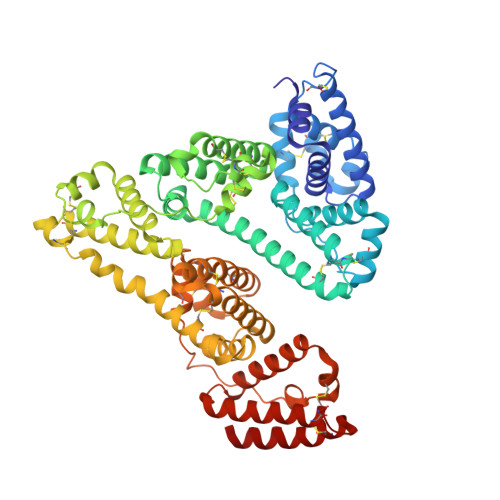Developing an Anticancer Copper(II) Multitarget Pro-Drug Based on the His146 Residue in the IB Subdomain of Modified Human Serum Albumin.
Wang, J., Gou, Y., Zhang, Z., Yu, P., Qi, J., Qin, Q., Sun, H., Wu, X., Liang, H., Yang, F.(2018) Mol Pharm 15: 2180-2193
- PubMed: 29722993
- DOI: https://doi.org/10.1021/acs.molpharmaceut.8b00045
- Primary Citation of Related Structures:
5YB1 - PubMed Abstract:
Designing a multitarget anticancer drug with improved delivery and therapeutic efficiency in vivo presents a great challenge. Thus, we proposed to design an anticancer multitarget metal pro-drug derived from thiosemicarbazone based on the His146 residue in the IB subdomain of palmitic acid (PA)-modified human serum albumin (HSA-PA). The structure-activity relationship of six Cu(II) compounds with 6-methyl-2-formylpyridine- 4 N-substituted thiosemicarbazones were investigated, and then the multitarget capability of 4b was confirmed in cancer cell DNA and proteins. The structure of the HSA-PA-4b complex (HSA-PA-4b) revealed that 4b is bound to the IB subdomain of modified HSA, and that His146 replaces the nitrate ligand in 4b, coordinating with Cu 2+ , whereas PA is complexed with the IIA subdomain by its carboxyl forming hydrogen bonds with Lys199 and His242. In vivo data showed that 4b and the HSA-PA-4b complex inhibit lung tumor growth, and the targeting ability and therapeutic efficacy of the PA-modified HSA complex was stronger than 4b alone.
Organizational Affiliation:
State Key Laboratory for the Chemistry and Molecular Engineering of Medicinal Resources , Guangxi Normal University , Guilin , Guangxi 541003 , China.
















